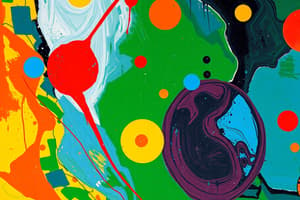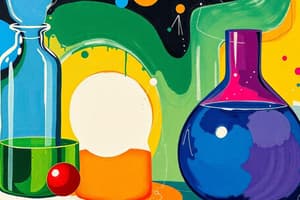Podcast
Questions and Answers
Atoms are the smallest fundamental units of matter and are composed of a nucleus and an electron cloud.
Atoms are the smallest fundamental units of matter and are composed of a nucleus and an electron cloud.
True (A)
Isotopes of an element have the same atomic mass but different atomic numbers.
Isotopes of an element have the same atomic mass but different atomic numbers.
False (B)
Anions are negatively charged ions formed when an atom gains one or more electrons.
Anions are negatively charged ions formed when an atom gains one or more electrons.
True (A)
Ionic bonds typically occur between two nonmetals.
Ionic bonds typically occur between two nonmetals.
The charge of a neutron is negative one.
The charge of a neutron is negative one.
Physical properties of a substance can be observed without changing the substance's identity.
Physical properties of a substance can be observed without changing the substance's identity.
Intensive properties, like volume, depend on the amount of matter present.
Intensive properties, like volume, depend on the amount of matter present.
A substance's tendency to change color when exposed to another chemical is a chemical property.
A substance's tendency to change color when exposed to another chemical is a chemical property.
Gases have a definite shape and are not compressible.
Gases have a definite shape and are not compressible.
Dissolving sugar in coffee is an example of a chemical change.
Dissolving sugar in coffee is an example of a chemical change.
Flashcards
Physical Properties
Physical Properties
Characteristics of a substance that can be observed without altering its identity.
Intensive vs Extensive Properties
Intensive vs Extensive Properties
Intensive properties do not depend on amount (e.g., odor), extensive do (e.g., volume).
Chemical Properties
Chemical Properties
Characteristics that determine how a substance reacts with others; includes color change or heat emission.
States of Matter
States of Matter
Signup and view all the flashcards
Phase Changes
Phase Changes
Signup and view all the flashcards
Atom
Atom
Signup and view all the flashcards
Subatomic Particle
Subatomic Particle
Signup and view all the flashcards
Isotope
Isotope
Signup and view all the flashcards
Ion
Ion
Signup and view all the flashcards
Ionic Bond
Ionic Bond
Signup and view all the flashcards
Study Notes
Properties of Matter
- Substances are described by properties, classified as physical or chemical.
- Physical properties are observed without changing the substance's identity (reversible changes).
- Examples: color, hardness, conductivity, density.
- Physical properties can be intensive (independent of quantity) or extensive (dependent on quantity).
- Examples: odor (intensive), volume (extensive).
- Chemical properties describe how a substance reacts with others.
- Examples: tendency to combine with other substances, change color, or release heat.
States of Matter
- Matter exists as solids, liquids, and gases.
- Solids: atoms are closely packed, fixed position, definite shape and volume.
- Liquids: atoms are loosely bonded, indefinite shape, definite volume.
- Gases: atoms move freely, indefinite shape and volume, compressible.
- Phase changes involve changes between states:
- Melting (solid to liquid): increase in energy/temperature.
- Freezing (liquid to solid): decrease in temperature.
- Vaporization (liquid to gas): addition of energy.
- Condensation (gas to liquid): cooling of vapor.
Atoms and Elements
- Atoms are the fundamental building blocks of matter.
- Composed of a nucleus (protons and neutrons) and electron cloud.
- Subatomic particles:
- Protons: positive charge, located in nucleus.
- Neutrons: neutral charge, located in nucleus.
- Electrons: negative charge, located in electron cloud.
- Atoms are too small to see directly, understood through models.
- Elements are different types of atoms with unique properties; defined by the number of protons.
The Periodic Table
- The periodic table organizes all known elements.
- Each element has an atomic number (number of protons).
- Elements' characteristics are determined by their atomic number, how they might interact with other elements.
Isotopes
- Isotopes are different forms of an element with the same number of protons and electrons but different numbers of neutrons.
- Isotopes are characterized by their atomic masses.
- Stable isotopes have stable ratios of protons and neutrons.
- Radioactive isotopes are unstable and undergo radioactive decay.
- Isotopic abundance is the relative amount of each isotope in nature. Measured using mass spectrometry.
Ions
- Ions form when atoms gain or lose electrons, creating a charge.
- Cations: positive ions (lose electrons).
- Anions: negative ions (gain electrons).
- Ions can be single atoms, molecules, or larger groups.
- Monoatomic ions: ions consisting of one atom
- Polyatomic ions: ions consisting of multiple atoms.
- Ionic bonds form between metals and nonmetals. Covalent bonds form between nonmetals.
Types of Compounds
- Compounds can be ionic or covalent.
- Ionic compounds: formed by the attraction between positively charged metal cations and negatively charged nonmetal anions.
- Covalent compounds: formed by sharing electrons between nonmetal atoms.
Mixtures and Pure Substances
- Mixtures can be separated without changing their chemical composition.
- Pure substances:
- Elements are made from one type of atom.
- Compounds have two or more different types of atoms in a fixed ratio.
Chemical Bonds
- Two main types of bonds:
- Ionic bonds: transfer of electrons between atoms.
- Covalent bonds: sharing of electrons between atoms.
- Metallic bonds: in metals, electrons move freely between atoms.
- Polar covalent bonds: electrons are shared unevenly between atoms.
- Non-polar covalent bonds: electrons are shared equally between atoms.
- Hydrogen bonds: attractive forces between a hydrogen atom and another strongly electronegative atom(like oxygen or nitrogen).
Studying That Suits You
Use AI to generate personalized quizzes and flashcards to suit your learning preferences.



